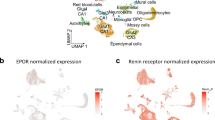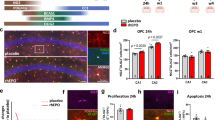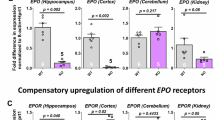Abstract
Because erythropoietin (Epo) is intensively studied as neuroprotective agent, Epo receptor (EpoR) regulation in neurons is of particular interest. Herein, we investigated molecular mechanisms of EpoR regulation in neuronal cells including the role of GATA transcription factors. First, developmental downregulation of EpoR expression in murine brain was observed. A differential expression pattern of the Gata factors was found in these specimens as well as in murine adult neural stem cells (NSC) and primary rat neurons, astrocytes, and microglia. Human SH-SY5Y cells served as a model to analyze EpoR regulation. In vitro binding of GATA-2, -3, and -4 to the 5′-flanking region was demonstrated. In reporter gene assays, the activity of a region containing two GATA binding sites was significantly induced when these GATA factors were overexpressed. However, GATA factors alone did not affect endogenous EpoR expression. Importantly, EpoR transcripts have doubled under hypoxia. Furthermore, we analyzed the methylation pattern close to the GATA motifs. Indeed, demethylation with 5-Aza-2′-deoxycytidine (Aza) resulted in upregulation of EpoR mRNA. Additionally, several CpGs were mostly nonmethylated in SH-SY5Y cells, but methylated in specific regions of the human adult brain. Thus, methylation may be involved in developmental EpoR downregulation.
Similar content being viewed by others
Log in or create a free account to read this content
Gain free access to this article, as well as selected content from this journal and more on nature.com
or
Abbreviations
- Aza:
-
5-Aza-2′-deoxycytidine
- E:
-
embryonic day
- Epo:
-
erythropoietin
- EpoR:
-
erythropoietin receptor
- FOG:
-
friend-of-GATA
- NSC:
-
neural stem cells
- nt:
-
nucleotide(s)
- rEpo:
-
recombinant Epo
References
Arcasoy MO 2008 The non-haematopoietic biological effects of erythropoietin. Br J Haematol 141: 14–31
Digicaylioglu M, Lipton SA 2001 Erythropoietin-mediated neuroprotection involves cross-talk between Jak2 and NF-kappaB signalling cascades. Nature 412: 641–647
Yu X, Shacka JJ, Eells JB, Suarez-Quian C, Przygodzki RM, Beleslin-Cokic B, Lin CS, Nikodem VM, Hempstead B, Flanders KC, Costantini F, Noguchi CT 2002 Erythropoietin receptor signalling is required for normal brain development. Development 129: 505–516
Tsai PT, Ohab JJ, Kertesz N, Groszer M, Matter C, Gao J, Liu X, Wu H, Carmichael ST 2006 A critical role of erythropoietin receptor in neurogenesis and post-stroke recovery. J Neurosci 26: 1269–1274
Chen ZY, Asavaritikrai P, Prchal JT, Noguchi CT 2007 Endogenous erythropoietin signaling is required for normal neural progenitor cell proliferation. J Biol Chem 282: 25875–25883
Liu C, Shen K, Liu Z, Noguchi CT 1997 Regulated human erythropoietin receptor expression in mouse brain. J Biol Chem 272: 32395–32400
Brines M, Grasso G, Fiordaliso F, Sfacteria A, Ghezzi P, Fratelli M, Latini R, Xie QW, Smart J, Su-Rick CJ, Pobre E, Diaz D, Gomez D, Hand C, Coleman T, Cerami A 2004 Erythropoietin mediates tissue protection through an erythropoietin and common beta-subunit heteroreceptor. Proc Natl Acad Sci USA 101: 14907–14912
Chin K, Yu X, Beleslin-Cokic B, Liu C, Shen K, Mohrenweiser HW, Noguchi CT 2000 Production and processing of erythropoietin receptor transcripts in brain. Brain Res Mol Brain Res 81: 29–42
Spandou E, Papoutsopoulou S, Soubasi V, Karkavelas G, Simeonidou C, Kremenopoulos G, Guiba-Tziampiri O 2004 Hypoxia-ischemia affects erythropoietin and erythropoietin receptor expression pattern in the neonatal rat brain. Brain Res 1021: 167–172
Nagai A, Nakagawa E, Choi HB, Hatori K, Kobayashi S, Kim SU 2001 Erythropoietin and erythropoietin receptors in human CNS neurons, astrocytes, microglia, and oligodendrocytes grown in culture. J Neuropathol Exp Neurol 60: 386–392
Zon LI, Youssoufian H, Mather C, Lodish HF, Orkin SH 1991 Activation of the erythropoietin receptor promoter by transcription factor GATA-1. Proc Natl Acad Sci USA 88: 10638–10641
Gritti A, Galli R, Vescovi AL 2001 Cultures of stem cells of the central nervous system. In: Fedoroff S, Richardson A (eds) Protocols for Neural Cell Culture. Humana Press, Totowa, New Jersey, pp 173–198
Harms C, Lautenschlager M, Bergk A, Freyer D, Weih M, Dirnagl U, Weber JR, Hortnagl H 2000 Melatonin is protective in necrotic but not in caspase-dependent, free radical-independent apoptotic neuronal cell death in primary neuronal cultures. FASEB J 14: 1814–1824
Ruscher K, Freyer D, Karsch M, Isaev N, Megow D, Sawitzki B, Priller J, Dirnagl U, Meisel A 2002 Erythropoietin is a paracrine mediator of ischemic tolerance in the brain: evidence from an in vitro model. J Neurosci 22: 10291–10301
Dame C, Sola MC, Lim KC, Leach KM, Fandrey J, Ma Y, Knopfle G, Engel JD, Bungert J 2004 Hepatic erythropoietin gene regulation by GATA-4. J Biol Chem 279: 2955–2961
Dame C, Kirschner KM, Bartz KV, Wallach T, Hussels CS, Scholz H 2006 Wilms tumor suppressor, Wt1, is a transcriptional activator of the erythropoietin gene. Blood 107: 4282–4290
Stolze I, Berchner-Pfannschmidt U, Freitag P, Wotzlaw C, Rossler J, Frede S, Acker H, Fandrey J 2002 Hypoxia-inducible erythropoietin gene expression in human neuroblastoma cells. Blood 100: 2623–2628
Um M, Gross AW, Lodish HF 2007 A “classical” homodimeric erythropoietin receptor is essential for the antiapoptotic effects of erythropoietin on differentiated neuroblastoma SH-SY5Y and pheochromocytoma PC-12 cells. Cell Signal 19: 634–645
Elliott S, Busse L, Bass MB, Lu H, Sarosi I, Sinclair AM, Spahr C, Um M, Van G, Begley CG 2006 Anti-Epo receptor antibodies do not predict Epo receptor expression. Blood 107: 1892–1895
Kirkeby A, van Beek J, Nielsen J, Leist M, Helboe L 2007 Functional and immunochemical characterisation of different antibodies against the erythropoietin receptor. J Neurosci Methods 164: 50–58
Morishita E, Masuda S, Nagao M, Yasuda Y, Sasaki R 1997 Erythropoietin receptor is expressed in rat hippocampal and cerebral cortical neurons, and erythropoietin prevents in vitro glutamate-induced neuronal death. Neuroscience 76: 105–116
Shingo T, Sorokan ST, Shimazaki T, Weiss S 2001 Erythropoietin regulates the in vitro and in vivo production of neuronal progenitors by mammalian forebrain neural stem cells. J Neurosci 21: 9733–9743
Chin K, Oda N, Shen K, Noguchi CT 1995 Regulation of transcription of the human erythropoietin receptor gene by proteins binding to GATA-1 and Sp1 motifs. Nucleic Acids Res 23: 3041–3049
Maouche L, Lucien N, Cartron JP, Chretien S 1995 A CCACC motif mediates negative transcriptional regulation of the human erythropoietin receptor. Eur J Biochem 233: 793–799
Kirschner KM, Hagen P, Hussels CS, Ballmaier M, Scholz H, Dame C 2008 The Wilms' tumor suppressor Wt1 activates transcription of the erythropoietin receptor in hematopoietic progenitor cells. FASEB J 22: 2690–2701
Zhou Y, Yamamoto M, Engel JD 2000 GATA2 is required for the generation of V2 interneurons. Development 127: 3829–3838
Lim KC, Lakshmanan G, Crawford SE, Gu Y, Grosveld F, Engel JD 2000 Gata3 loss leads to embryonic lethality due to noradrenaline deficiency of the sympathetic nervous system. Nat Genet 25: 209–212
Lawson MA, Mellon PL 1998 Expression of GATA-4 in migrating gonadotropin-releasing neurons of the developing mouse. Mol Cell Endocrinol 140: 157–161
Craven SE, Lim KC, Ye W, Engel JD, de Sauvage F, Rosenthal A 2004 Gata2 specifies serotonergic neurons downstream of sonic hedgehog. Development 131: 1165–1173
Moriguchi T, Takako N, Hamada M, Maeda A, Fujioka Y, Kuroha T, Huber RE, Hasegawa SL, Rao A, Yamamoto M, Takahashi S, Lim KC, Engel JD 2006 Gata3 participates in a complex transcriptional feedback network to regulate sympathoadrenal differentiation. Development 133: 3871–3881
Maouche L, Cartron JP, Chretien S 1994 Different domains regulate the human erythropoietin receptor gene transcription. Nucleic Acids Res 22: 338–346
Chiba T, Ikawa Y, Todokoro K 1991 GATA-1 transactivates erythropoietin receptor gene, and erythropoietin receptor-mediated signals enhance GATA-1 gene expression. Nucleic Acids Res 19: 3843–3848
Lu JR, McKinsey TA, Xu H, Wang DZ, Richardson JA, Olson EN 1999 FOG-2, a heart- and brain-enriched cofactor for GATA transcription factors. Mol Cell Biol 19: 4495–4502
Acknowledgements
Olaf Hoffmann and Dorette Freyer (Klinik für Neurologie, Charité—Universitätsmedizin Berlin) kindly provided the brain-derived isolated cells. Malte Cremer (Klinik für Neonatologie) performed statistical analysis.
Author information
Authors and Affiliations
Corresponding author
Additional information
Supported by the Jürgen Manchot Stiftung, doctoral fellowship from the Humboldt-Universität Berlin/Charité—Universitätsmedizin Berlin (I.W.), the Deutsche Forschungsgemeinschaft (DA 484/2-1) (C.D.), and a grant from the Roche Foundation for Anaemia Research (ID 5463534641).Current address (FKHL): Institute of Neuropathology, Universitätsklinikum Bonn, Sigmund-Freud-Strasse 25, D-53105 Bonn, Germany.
Rights and permissions
About this article
Cite this article
Wallach, I., Zhang, J., Hartmann, A. et al. Erythropoietin-Receptor Gene Regulation in Neuronal Cells. Pediatr Res 65, 619–624 (2009). https://doi.org/10.1203/PDR.0b013e31819ea3b8
Received:
Accepted:
Issue date:
DOI: https://doi.org/10.1203/PDR.0b013e31819ea3b8
This article is cited by
-
Methylation of the first exon in the erythropoietin receptor gene does not correlate with its mRNA and protein level in cancer cells
BMC Genetics (2019)
-
Erythropoietin monotherapy in perinatal asphyxia with moderate to severe encephalopathy: a randomized placebo-controlled trial
Journal of Perinatology (2017)
-
GATA factors in human neuroblastoma: distinctive expression patterns in clinical subtypes
British Journal of Cancer (2009)



